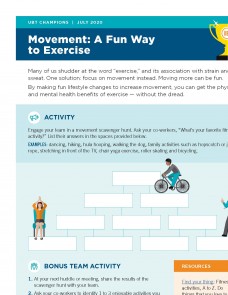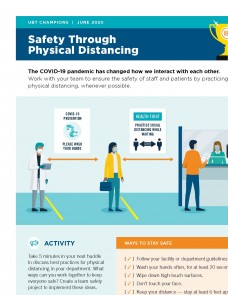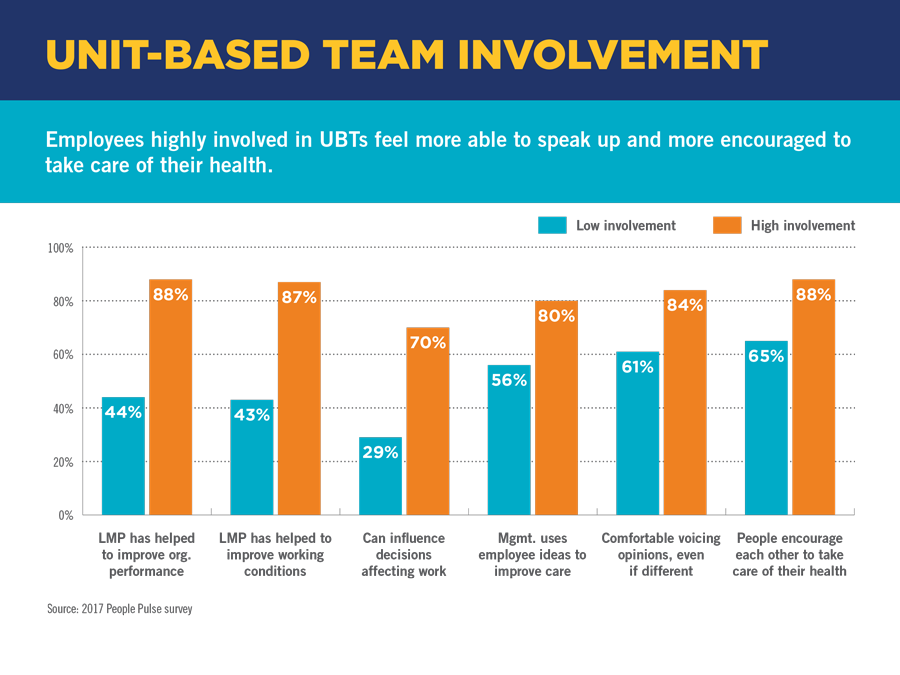TOOLS
Deck
Labor pools fill staffing gaps
COVID-19 is testing partnership as never before.
Management and labor have had to work together quickly to retool the delivery system to support rapidly changing needs. Employees’ and physicians’ skills and talents are needed in new ways and in new places — so leaders from Kaiser Permanente and unions created labor pools to get KP employees to where they were needed.
It’s one of dozens of innovations made to provide top-quality care at a time when every day is bringing new challenges. The swift work was possible in part because of the foundation provided by the relationships and values of the Labor Management Partnership.
In Southern California's Riverside service area, “It’s all-hands on deck,” says Jiji Abraham, area chief financial officer. “Even physicians are in the labor pool.”
TOOLS
Deck
Explore career options with new career paths tool
Kerene Hoilett always knew she wanted to work in health care — inspired by her grandmother, a nurse.
When she learned that nursing didn’t fit her, she forged her own path.
Hoilett joined Kaiser Permanente in 2007 as an ultrasound technologist in Georgia. Since then, she has completed a project management certificate, landed an internship and earned 2 college degrees on her way to becoming a diagnostic imaging quality consultant.
“I always have that drive to challenge myself,” Hoilett says. “How can I tap into my strengths more?”
To help employees and managers tap into their strengths, Kaiser Permanente has a new career paths tool.
The new tool at kpcareerplanning.org/paths is interactive and personalized to help you explore career options. Follow the prompts to fill out a profile and find opportunities that link your skills, interests and education to careers at Kaiser Permanente.
“Kaiser Permanente encourages career mobility,” says Monica Morris, director of National Workforce Planning and Development. “With career paths, we’re trying to show you all the different career opportunities and directions you could go in the organization.”
Partnership unions negotiated to include career paths in the 2005 National Agreement with Kaiser Permanente.
“The new career paths tool reinforces our commitment to supporting lifelong learning and career development,” says Jessica Butz, workforce development director with the Alliance of Health Care Unions. “Career paths are a fundamental piece to help give employees a road map for success.”
Pursuing opportunities
After Hoilett became lead ultrasonographer in 2013, her journey took a turn to pursue leadership opportunities.
As a United Food and Commercial Workers (UFCW) member, Hoilett talked with a Partnership union-supported career counselor from the Ben Hudnall Memorial Trust, leading her to a project management pilot program. A project management certificate and 6-month internship at the regional office followed. The trust paid her to work at the internship one day a week, while she worked her regular job 4 days a week.
Hoilett applied for open positions but was unsuccessful, so she reviewed her experience gap with her career counselor.
“She encouraged me. I knew one day I would get that opportunity, and she helped me to be confident,” Hoilett says. “I wasn’t left in the dark. The career counselor was able to light my path.”
Hoilett’s persistence paid off. In 2018, she earned her master’s degree in project management and became a diagnostic imaging quality consultant. She’s using her people, project and technical skills to improve productivity and performance for imaging techs.
She isn’t stopping there. She continues to increase her impact in her current role while exploring learning opportunities in organizational leadership. And she encourages colleagues to learn, take courses and grow their careers — just like her.
“Don’t be afraid,” Hoilett says. “If you keep going, you will be successful.”
TOOLS
Videos
()
This labor and delivery team cultivates a #FreeToSpeak culture, which has helped members provide consistently excellent care and service to new moms.
TOOLS
Deck
Positive results for KP members, patients and workers
Do teams get better results when frontline workers are engaged, free to speak and can influence decisions? Yes, say the people who know best — Kaiser Permanente workers and managers themselves.
Recent People Pulse surveys confirm that unit-based teams get positive results for health plan members and patients, the organization and workers themselves.
For instance, the 2017 People Pulse survey of more than 155,000 KP employees showed that when union-represented employees are highly involved in UBT activities, they get 29 percent higher scores on measures of their willingness to speak up — a key driver of patient and workplace safety and satisfaction. They also get 33 percent higher scores on questions regarding workplace health and wellness.
Improved safety and satisfaction
Further analysis, included in the 2016 People Pulse survey, showed that teams with high employee involvement have:
- 18 percent fewer workplace injuries
- 13 percent fewer lost work days
- 4 percent higher patient satisfaction
“Our findings show that employees who are highly involved in their unit-based teams feel more able to speak up and more encouraged to take care of their health,” says Nicole VanderHorst, principal research consultant with KP Engagement & Inclusion Analytics. “That makes them more likely to have better performance outcomes.”
A better way to work
Workers’ greater propensity to speak up and look after their health when they’re involved in team activities covers several questions (see chart below). For example, workers who are highly involved in their UBTs are far more likely to say:
- The Labor Management Partnership has helped improve organizational performance and working conditions.
- They can influence decisions affecting their work.
- They’re comfortable voicing differing opinions.
- Management uses their ideas to improve care.
- They’re encouraged, and encourage others, to take care of their health.
Roots of workforce engagement
All these factors contribute to a better employee experience as well as performance. And UBTs reflect KP’s unique history with the labor movement.
“Henry Kaiser was perhaps the 20th century’s most worker-friendly industrialist. He supported organized labor and knew that people step up when allowed to exert their job experience, as they do with UBTs,” says KP archivist and historian Lincoln Cushing. “He trusted employees to make decisions that benefitted themselves and their organizations.”
If you belong to a unit-based team — and most union-represented employees do — talk with a team co-lead about ways to get more involved.







